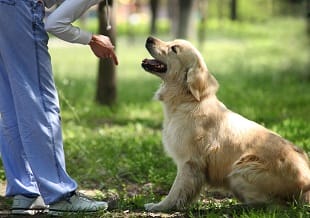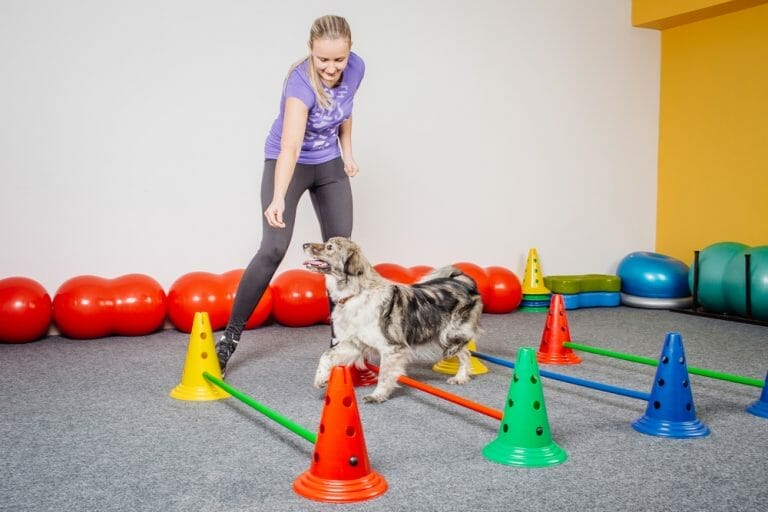Stop dreaming of the life you want, and start living it!
If you love everything about dogs then this course bundle is for you. Dog breeding, pet shops, vet clinics, dog training, canine behaviour therapist, dog grooming, dog boarding – these are just some examples of careers you may consider upon completion of our Dog Training, Care, and Grooming bundle course! Learn to groom dogs for better health and well-being; the different breeds suitable for which behaviour training; and know the science of dog care as you study its anatomy, physiology, nutrition and heath.
1. Dog Care start at the beginning with learning all about dogs and how to care for them. You will learn dog breeds, biology, behaviour and training, health care and nutrition in this comprehensive introduction to canine care. You will learn how to provide effective care for dogs as well understand the different goods and services within the canine industry.
2. Dog Grooming This practical animal grooming online course is delivered online and will give you the skills and knowledge you need gain competency in animal grooming. It is suitable for both enthusiasts and professionals. Recommended for those wanting to be professional animal groomers, or for people working in the pet care and pet shop industry, dog groomers, dog and cat owners and so on. While this course has a strong focus on dog grooming. Learn animal grooming with a focus on dog grooming. You will learn basic biology, coat and skin care, grooming techniques, show prep, handling animals and specialised grooming tasks.
3. Dog Psychology & Training An understanding of canine psychology and behaviour is vitally important for anyone who works with dogs or keeps them as a companion animal. Understanding how the domesticated dog has developed anatomically and physiologically from its wild counterpart, the wolf, will helps us to understand behaviours commonly seen in today’s domesticated dog and therefore allows us to provide an environment in which the dog remains a happy and healthy companion.You will learn canine psychology and how to apply it to dog handling and training, including obedience, working dogs, controlling dogs movement and canine behavioural problems.
- 100% online but still practical
- Endorsed by the IARC
- Full tutor support
- Study now Pay Later options
- Established college (10 years)
- Self paced study to fit into your life
- No prior knowledge necessary

What do our students say?



Lesson Outlines

1. Get your foundation strong
Start at the beginning and learn the essentials of canine physiology and how this relates to the dogs wellbeing, longevity and health. Use this knowledge to learn about the daily requirements such as nutrition and care. Following you will learn over two modules about dog health maintenance and about illness and different treatments. Dog breeds and breeding will be examined as well as an introduction to the dog breeding industry including legalities. Training and dog grooming are introduced. You can read more by selecting the link below.

2. Learn to groom
In Stage 2 you will learn all about grooming starting with an introduction to the dog grooming including common tools, brushes, and all the grooming basics. Before you go further you will dive deeper into the biology of skin, hair, horns, nails, claws and more. Armed with this essential knowledge you will then learn how to care for skin and coats including nutrition, skin problems, pest control and more. Next up you will learn a bit of animal psychology as well as how to restrain animals safely and calmly for grooming. Then on to dogs grooming, as well as other animals. How to prep for shows, and the ins and outs of the dog grooming industry. You can read more by selecting the link below.

3. Become a dog trainer
Finally Stage 3 and onto dog psychology & training! You will start with an introduction to the topic, then onto learning about how canines sense the world around them and how this relates to their behaviour and training them. Using this you will then examine what is natural canine behaviour followed by how dogs temperament and behaviour develop. With this knowledge you will then learn about behaviour disorders in dogs and what to do. Then you will learn the basics of dog training and dog obedience. How to control a dogs movement safely and without stress is then covered followed by training working dogs. You can read more by selecting the link below.
There are 9 Lessons in this course:
1. Introduction to Dog Care
- What Dogs Need
- Food
- Water
- Physical and Psychological Environment
- Exercise
- Hygiene
- Importance of Routine
- Potential Problems and Owner Error
- Uncertainty of pack position
- Neglect
- Escaping
- Attacking other people and animals
- Physical damage
- Illness
- Which Breed is best
- Choosing a puppy or adult dog
- Outside living or inside pet
- Restricting and confining a pet
- Dealing with holidays
- Training dogs
- Socialising with other animals
- Scope of Dog care industry
2. Canine Biology
- Anatomy
- Mouth
- Teeth
- Ears
- Eyes
- Skeletal system
- Digestive system
- Normal physiological values
- Circulation
- Respiratory rates
- Thermoregulation
3. Dog Health Part 1
- Introduction to nutrition and feeding
- Nutritional Components
- Carbohydrates
- Proteins
- Fats
- Minerals
- Vitamins
- Water
- Changing requirements through different life stages
- Growth period
- Working and high performance period
- Pregnancy and lactation period
- Geriatric period
- Feeding patterns -time controlled or free choice
- Feed products
- Commercial foods
- Medicinal/veterinary foods
- Home cooked Foods
- Snacks and treats
- Foods to avoid
- Common nutritional disorders
- Allergies
- Poisoning
- Preventative health
- Diet supplements
- Immunisation
- Worms, tick and flea prevention
- Exercise
- Dental care
- Skin and Nail Care
- Basic First Aid Equipment
- Assessing the Situation in an Emergency
- What to do… (in accidents or at specific times)
- Basic Resuscitation and CPR
4. Dog Health Part 2 -Illnesses and Treatments
- Introduction
- Haemobartonellosis
- Babesiosis
- Von Willebrand’s Disease
- Aortic Stenosis
- Heart Failure
- Heart Murmurs and Arrhythmias
- Hypertension (High Blood Pressure)
- Heartworm
- Vomiting
- Diarrhoea
- Giardia
- Intestinal Worms
- Enteritis
- Inflammatory Bowel Disease (IBD)
- Diabetes Mellitus
- Cushing’s Disease (Hyperadrenocorticism)
- Hypothyroidism
- Postpartum Hypocalcaemia (Eclampsia)
- Conjunctivitis
- Glaucoma
- Cataracts
- Ear mites
- Deafness
- Anaphylactic Shock
- Lupus
- Hip Dysplasia
- Osteoarthritis
- Epilepsy
- Canine Degenerative Myelopathy (CDM)
- Canine Distemper
- Infectious Canine Tracheobronchitis (Kennel Cough)
- Asthma
- Mange
- Ringworm
5. Dog Breeds
- Gundogs, Hounds, Pastoral, Terriers, Toy, Utility, Working
- English Setter
- Irish Setter
- German Pointer
- Golden Retriever
- Labrador Retriever
- Cocker Spaniel
- Hungarian Vizsla
- Beagle
- Dachshund
- Greyhound
- Irish Wolfhound
- Bassett Hound
- Australian Cattle dog
- Border Collie
- German Shepherd
- Old English Sheep Dog
- Corgi
- Staffordshire Bull Terrier
- West Highland Terrier
- Parson (Jack) Russell Terrier
- Australian terrier
- Scottish terrier
- Chihuahua
- Bichon Frisé
- Cavalier King Charles Spaniel
- Pomeranian
- Pug
- Dalmatian
- Poodle
- Schnauzer
- Shih Tzu
- Alaskan Malumute
- Great Dane
- Mastiff
- Newfoundland
- St Bernard
6. Breeding
- Introduction
- Female Reproductive System
- Male Reproductive System
- Sexual Behaviour
- Mating Interaction
- The Management of Reproduction
- Desexing/Neutering/Spaying/Castrating
- Pregnancy and birth
- Parturition (Labour)
- Suckling
- Weaning
- Factors Influencing Puppy Size
- Puppy Development
- The breeding industry
- ‘Back-yard’ Breeders & Breeding for fun
- Illegal Commercial Puppy Breeding Enterprises (Puppy Mills)
- Breeding for Profit
- Legislation and Licensing
7. Dog Behaviour and Training
- Understanding dog behaviour
- The Importance of Training
- Practical training techniques
- Technique for Recall
- Technique for Sit (in front)
- Technique for Sit (at the side)
- Technique for Stand (Beside)
- Technique for Leave
- Technique for Down/Lay
- Technique for Stay (beside)
- Technique for Heeling
- Behaviour Problems Present Opportunities for Business
- Attributes of Successful Dog Trainers
- Practical for Business Start-up
8. Grooming
- The Importance of Grooming
- Grooming tools and equipment
- What to groom, why and how
- Skin
- Bathing
- Coat (hair)
- Brushing
- Claws (nails)
- Teeth
- Teeth brushing
- Ears
- Professional grooming
- Long haired dog breeds
- Short hair breeds
- Other breeds
- Styles and clips
9. Other Dog Services
- Health and related services
- Training and related services
- Day care and long term stay services
- Assistance dog services
- Professional dog handling
- Retail related services
There are 10 lessons in this course:
1. Scope and Nature of Grooming
- Introduction to grooming behaviour
- Why do humans groom animals?
- What animals are groomed?
- Generic grooming tasks
- Common tools and equipment
- Combs, brushes, rakes, blades and other equipment
- Confidently handling animals Introduction
- The industry and workplace opportunities
- Workplace skills
2. Animal Biology
- Skin – Epidermis & Dermis
- Claws, Nails and Spurs
- Hair
- Horns
- Hooves
- Physiological control – Homeostasis
- Thermoregulation
3. Caring for the Skin and Coat
- Animal nutrition
- General nutrition
- Micronutrition
- Water requirements
- Common skin problems in dogs and cats
- Ringworm – fungal infection
- Flea and flea control
- Ticks and tick control
- Lice and control
- Mites (mange) and control
- Treating skins problems in dogs and cats
- Common skin problems in equines
- Caring for the coat – brushing, bathing, blowdrying, dematting, clipping, trimming
- Removing burrs from fur
- Caring for cats – combing, brushing and bathing
4. Specialised Grooming Tasks Risks of Working with Animals
- Selecting a suitable grooming location
- Understanding animal psychology and behaviour
- The flight or fight response
- Environmental Influence on behaviour in zoo animals
- General considerations when handling animals
- Pre-restraint techniques
- Physical restraint
- Medical restraint – sedation
- Safely handling different animals when grooming: dogs, cats, cattle, poultry, rabbits, captive wildlife
- Handling Horses: Safe and Respectful
- Catching, releasing, leading, tying up and working around the horse
- Indicators of pain, mild fear and extreme fear
- Transporting horses
5. Handling Animals
- Risks of working with animals
- Selecting a suitable grooming location
- Understanding animal psychology and behaviour
- The flight or fight response
- Environmental Influence on behaviour in zoo animals
- General considerations when handling animals
- Pre-restraint techniques
- Physical restraint
- Medical restraint – sedation
- Safely handling different animals when grooming: dogs, cats, cattle, poultry, rabbits, captive wildlife
- Handling Horses: Safe and Respectful
- Catching, releasing, leading, tying up and working around the horse
- Indicators of pain, mild fear and extreme fear
- Transporting horses
6. Grooming Dogs
- Communication in dogs
- Use of scent
- Barking & body language
- Grooming different types of dogs
- Long Coat types
- short coat types
- single coat types
- Double coat types
- Smooth coat types
- Wire haired coat types
- Woolly or wavy coat types
- Corded coat types
- Bald or hairless coat types
- Brushing and bathing care
- Clipping and styling
- Grooming procedures that can go wrong
- Cutting toenails too short
- Cuts or nicks when clipping
- Overheating
- Water trapped in the ear canal
7. Grooming Exotic Animals
- Grooming birds
- Handling birds
- Beaks
- Feathers
- Bathing birds
- Grooming rabbits
- Handling
- moulting
- Transporting
- Grooming captive wildlife
- Bathing small and large mammals
- Handling large animals and exotics
- Dangerous animals
- Fear of humans
- Issues with handling animals
- Psychological effects of different handling techniques
- Grooming areas
8. Safety in Grooming Workplace
- Safety for people and staff – workplace health and safety
- First aid
- Legislation and duty of care
- Safety of animal owners and visitors to the premises
- Protective equipment
- A groomer’s personal protection
- Equipment and workplace safety
- Storage and disposal of chemicals
- Handling Tools and Machinery
- Safety with tools and equipment
- Safety audit
- Example of an audit checklist
- Safety for animals and people
- Transportation
- Safety of the animal at the salon
- Electrical safety – at home and the groomers
- Slip risk – wet surfaces
- Cat and dog allergies
9. Preparing for Showing
- What is animal showing?
- Why do people show pets?
- Showing dogs
- Training your show puppy
- Preparing for show – dogs
- Days and evening before the show
- The day of the show and in the ring
- Showing – dress to impress
- Showing poultry
- Getting started – selecting your breed and buying your birds
- Preparing birds for show
- The day before the show
- The day of the show
- Showing cattle
- Preparing cattle for show
- In the show ring on the day
10. The Business of Grooming Planning a New Grooming Business
- The business plan
- Financial planning
- Long term goals
- Medium term goals
- Annual financial plan
- Financial records
- Commonly used finance related terminology
- Cash flow
- Make the business a success – know your market
- Insurance and risks – risk analysis and managing risk
- Groomers insurance
There are 9 lessons in this course:
1. Nature and Scope of Canine Psychology
- A brief history of the canine evolution
- Self-domestication
- Canine industries
2. Canine Senses
- Understanding canine communication
- Sight
- Body Language
- Smell
- Sound
- Elimination Postures
3. Understanding Natural Canine Behaviour
- Social Structure
- Social Behaviour
- Aggression
- Clinical Problems
- Biological Rhythms
- Sleep
- Sexual Behaviour
- Maternal Behaviour
- Parturition
- Suckling and Weaning
- Eating and Drinking
4. Canine Behavioural Development
- Nature or Nuture
- Sensitive Periods
- Neurological Development
- Canine Temperament Testing
- How Breeds Differ
5. Canine Behavioural Disorders
- Attention Seeking Behaviour
- Excessive barking
- Chewing
- Running away
- Chasing moving objects
- Begging
- Digging
- Separation anxiety
- Agression
- Phobias
- Excessive compulsive disorders
- Cognitive Dysfunction
- Calming a dog
6. Basic Dog Training
- Forming habits
- Conditioning
- Classical Conditioning
- Operant Conditioning
- Socialisation
- House training
- The use of visual signals
- The use of voice commands
- The use of training aids
7. Dog Obedience Training
- Practical Training Techniques
- Recall
- Sit
- Stand
- Drop
- Leave
- Down
- Stay
- Heel
- Seek
- Retrieve
- Bark on Signal
8. Controlling a Dogs Movement
- Territorial nature of dogs
- Fencing
- Dog doors
- Kennels
- Exercise requirements
- Socialisation requirments
- Walking on a lead/leash
- Electronic barriers
- Microchips
- Pet Registration and Licensing
- Controlling Killing Wildlife
9. Training Working Dogs
- Training for scent discrimination or substance detection
- Training for retrieving
- Guarding
- Hearing dogs
- Hearding
- Tracking
- Controlling attacks on animals and people
How it works
When you enrol, we create an account for you in our online learning portal. There you will be able to access all your course materials, upload assignments, receive feedback and more.
Entry Requirements
There are no prerequisites to complete this course. However, you must be able to read, analyse and comprehend, printed information in English, and to write statements and solve problems to complete the course. You must also have reliable access to a computer and a reliable internet connection and have basic computer skills.

F.A.Q.'s
Yes! Our courses are designed specifically for that. You can study our courses from nearly anywhere in Australia or even globally.
Don’t Panic! It’s ok, many of our students left school a long time ago, and many others are still new to online learning. We will help you each step along the way from enrolment, course access, completing your first module, getting your feedback and contacting your support tutor. We understand that it might not feel familiar to you, but we’re here to help.
Study with us is self-paced so that should generally be fine. But if you’ll be taking a few months off, it is best to contact Student Services so we can put your account on hold. We allow a one-time course suspension (free of charge) of up to 6 months, depending on the student’s course end date.
We accept enrollments all year round, thus our motto “Anytime, Anywhere”. Students can start their course upon enrolment or put it off at a later date. However, please do note that the courses have set end dates. If you’re starting at a later date, please let us know d
Yes, please scroll down to the bottom of the page for all of our payment options.
Yes this course is self paced. Work at your speed through the material. We have found students do best when submitting only one assignment at a time and waiting for feedback before submitting the next.
We allow 24 months duration within which you may finish the course within your own timeframe.
Flexible Payment Plan
-
Affordable
-
Interest Free
-
Pick your own start date
Pay Upfront & Save
Save and pay upfront using your Credit Card or PayPal-
Interest Free
-
Best Priced Option
-
Best Value
Fortnightly Payment
Enjoy flexible payments via Credit Card or Paypal-
Interest Free
-
Flexible Payment Plan
-
No Credit Check
Our promise to you
There are a lot of options for online learning, and we’re glad that you’ve decided to look into Careerline. We want to be your go-to learning spot, so we’ll make you these promises:
You’re never just a number. You’re a student with goals and challenges and we want to help you in any way we can.
Your goals matter. Whether you’re just starting a new hobby or trying to transform your career, your goal is important and it’s worth your time and our devoted attention.
When you reach out, we respond. You’re wondering right now, “Will they take my money and disappear?” When you join, you are part of the family. Need something? Just contact us and we’ll get right back to you. Have questions, concerns, or feedback about your learning? We love talking about learning, and we love talking to our customers, so we can’t wait for you to get in touch.
NEED HELP ORDERING OR HAVE QUESTIONS?
If you have any questions before you purchase, please contact us at via our online web form by clicking here
© Copyright Careerline Courses & Education Pty Ltd 2011 - 2022
